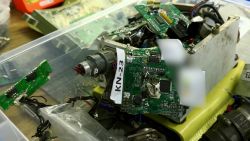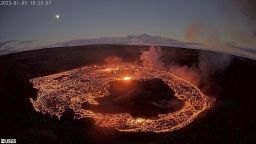Hawaii’s Kilauea volcano began erupting on Wednesday morning, the Hawaiian Volcano Observatory reported.
“At approximately 4:44 a.m. HST on June 7, 2023, the (US Geological Survey’s) Hawaiian Volcano Observatory detected glow in Kīlauea summit webcam images indicating that an eruption has commenced within Halemaʻumaʻu crater in Kīlauea’s summit caldera, within Hawai’i Volcanoes National Park,” the observatory said in a statement.
“The opening phases of eruptions are dynamic. Webcam imagery shows fissures at the base of Halemaʻumaʻu crater generating lava flows on the surface of the crater floor. The activity is confined to Halemaʻumaʻu and the hazards will be reassessed as the eruption progresses,” the HVO said.
The alert level for Kilauea was raised to red for “warning,” the observatory said.
The eruption is currently confined within the Hawai’i Volcanoes National Park. The observatory said it is in “constant communication” with park officials.
“At this time there is NO indication that populated areas are threatened,” the Hawaii Emergency Management Agency said on Twitter.
Live video from USGS shows glowing lava shooting into the air atop the volcano’s summit.
The National Park Service has listed the locations where people can safely watch the eruption, and those who wish to do so can view it from as close as half-a-mile away.
Tthe eruption “is expected to draw thousands of visitors” to the park, which is open 24 hours per day, the NPS said in a news release. Public visitors are urged to follow safety precautions, including staying on marked trails and overlooks and not entering closed areas, according to the release.
“Witnessing the crust of an active lava lake being dragged into seething fountains is unforgettable. While an eruption is an exciting experience, keep in mind you are observing a sacred event,” the NPS said.
Kilauea also erupted in January and showed signs of “heightened unrest” in May. The volcano had stopped erupting in December for the first time since September 2021. It was the first time that Kilauea and its neighbor, Mauna Loa, the world’s largest active volcano, had erupted simultaneously since 1984.
The lava from the 2021 eruption was contained to Kilauea’s summit crater, but a previous eruption in 2018 caused devastation. A slow-moving flood of lava destroyed hundreds of homes in the southeast area of Big Island and completely filled Kapoho Bay.
The lava flowing into the bay sent billowing clouds of steam into the atmosphere as hot lava hit the cool water of the Pacific Ocean. Officials at the time warned residents about laze, a nasty mashup of lava and haze that sends hydrochloric acid and volcanic glass particles into the air.
CNN’s Aya Elamroussi and Holly Yan, Paradise Afshar, Madison Park and Lauren Mascarenhas contributed to this report.

























